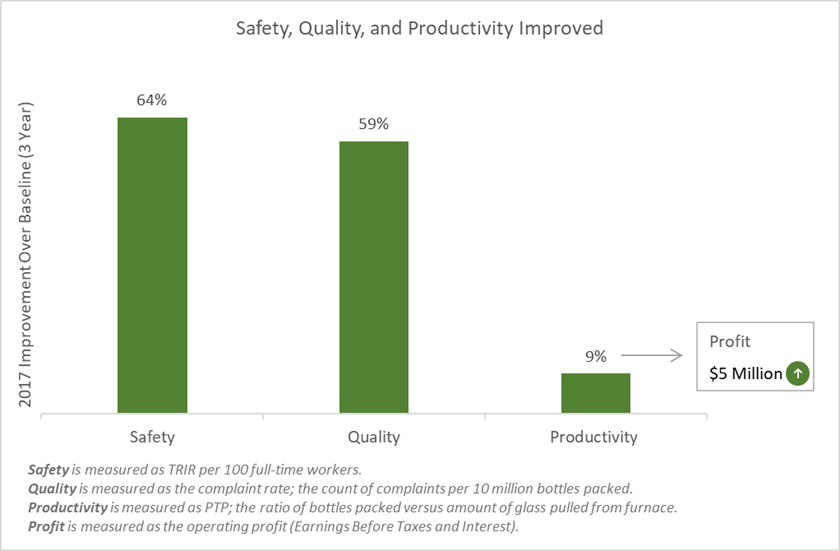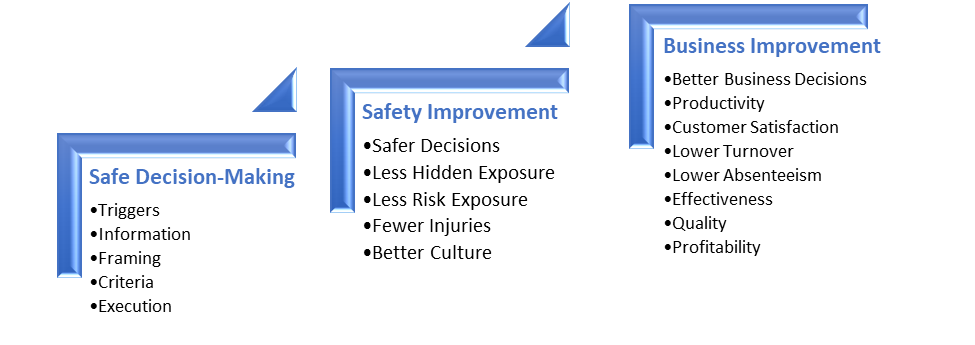March 15, 2019
The Case for Safety
Those of us who have devoted our careers to safety do it because we want to make a positive difference in peoples’ lives. Full stop. That’s the reason. But we also have a duty to our employers and clients to help them make smart business decisions. The good news is that we can do both – it is not an either or situation. The challenge is demonstrating the value that investment in safety delivers in a world so focused on the bottom line. This article is about the business case for safety and how time and investment in safety delivers value to an organization’s stakeholders and shareholders alike.
The business case for safety is based on an understanding of the essential links between safety and business performance. The influence of safety excellence in an organization shouldn’t—and really can’t—be confined just to safety, as these three fundamental links demonstrate:
Link #1 – Risk Reduction
The first link directly follows from risk reduction: When people put their minds to safety, they will get better at identifying and managing risk, which reduces exposure and leads to fewer injuries. Fewer injuries means lower costs and more time in production; all other things being equal, profits rise
[1]. Organizations in high-risk industries that face catastrophic risk take this link very seriously. They see risk management basically as a license to operate, because a catastrophic event could so easily put them out of business. Just ask PG&E.

While it matters a great deal, this link alone is hardly a silver bullet. Catastrophic events are rare, thankfully; so most of the time, this impact on profits through cost savings is meager, relative to other business drivers. What’s more, the focus required to manage risk is just not sustainable without some extra support. It needs to become the default expectation, or as soon as attention shifts to other objectives, exposure will rise and people get hurt. Anyone who has experienced the Accident Cycle knows this.
Link #2 – Culture
The second link is less tangible, yet immensely more powerful and longer term. When leaders lead a safety improvement effort in a way that engages employees while reducing risk, then not only does safety performance improve, but they also create the kind of culture that sustains the improvement and extends it to other aspects of the business.

For example, when people work in an environment where they feel like they matter, when they feel respected and valued, they can’t wait to show up to work. They want to be there and they give it their best effort. Through safety, leaders have the opportunity to develop and practice the leadership skills that develop this very special culture — the kind of culture that will sustain safety improvement in the long term, even when an individual leader’s attention shifts to another business issue.
Academic research shows that an organizational culture characterized by trusting relationships and a shared value for safety will extend beyond safety to elevate many other aspects of the business such as productivity, customer satisfaction, employee turnover, and organizational effectiveness
[2]. We have experienced the same in our consulting practice. For instance, when leaders at a glass manufacturing plant used this very strategy to improve safety, not only did safety improve 64% in the first year, but quality improved 59% and profit rose by 5 million dollars.

Link #3 – Safe Decision Making
Whereas the 2nd link has been demonstrated through research spanning multiple decades, the third link is just now emerging in the field of safety and has the potential to dwarf the other two in terms of impact for both safety and business. The link is Safe Decision Making®. Recent studies show the safety implications of managerial decisions such as facility design, work design, project management, and personnel assignment[3]. These same decisions cause employees to engage or disengage: When employees seeing leaders making poor decisions, they know it. And they disengage.
Within this finding is a powerful opportunity for safety improvement efforts to enhance the business. When leaders improve their decision making related to safety, two things happen. Not only do they foster employee engagement, but they increase their capability for better decisions overall. That’s not just good for business, it’s great for business.

These three links aren’t separate. Yes, each link on its own could justify investment in safety improvement, but together they show how the organization and its business are strengthened when its leaders approach safety improvement in the right way. When leaders make decisions for safety, workers are engaged, and the right culture is fostered—then the potential for the business is unlimited.
Make Your Case for Safety
Big visions require resources. In a world where resources are limited, safety leaders need to be able to demonstrate why their investment is not just the right thing for the workforce, it’s also the best thing for the business. If you approach safety improvement in a way that delivers value on multiple levels, give us a call: We can help you make your case.
[1]. See, for example, Goetzel, R. Z., Fabius, R., Fabius, D., Roemer, E. C., Thornton, N., Kelly, R. K., & Pelletier, K. R. (2015). The Stock Performance of C. Everett Koop Award Winners Compared With the Standard & Poor’s 500 Index. Journal of occupational and environmental medicine, 58(1), 9-15.
[2]. An extensive review of the literature on the first characteristic can be found in Eisenberger, R., & Stinglhamber, F. (2011). Perceived organizational support: Fostering enthusiastic and productive employees. Washington, D.C: American Psychological Association. See the body of research published by Dr. Dov Zohar and Dr. David Hofmann for the second characteristic.
[3].Bell, K. & Krause, T. (2015, July 25). Safe Decision Making for Safety Leaders: Part 1 [Blog post]. Retrieved from https://krausebellgroup.com/safe-decision-making-for-safety-leaders/ and Bell, K., Krause, T. & Libby, D. (2015, July 28). Safe Decision Making for Safety Leaders: Part 2 [Blog post]. Retrieved from https://krausebellgroup.com/safe-decision-making-for-safety-leaders-part-2/.
The Case for Safety
March 15, 2019
By Kristen BellShare this post:
Search for articles


